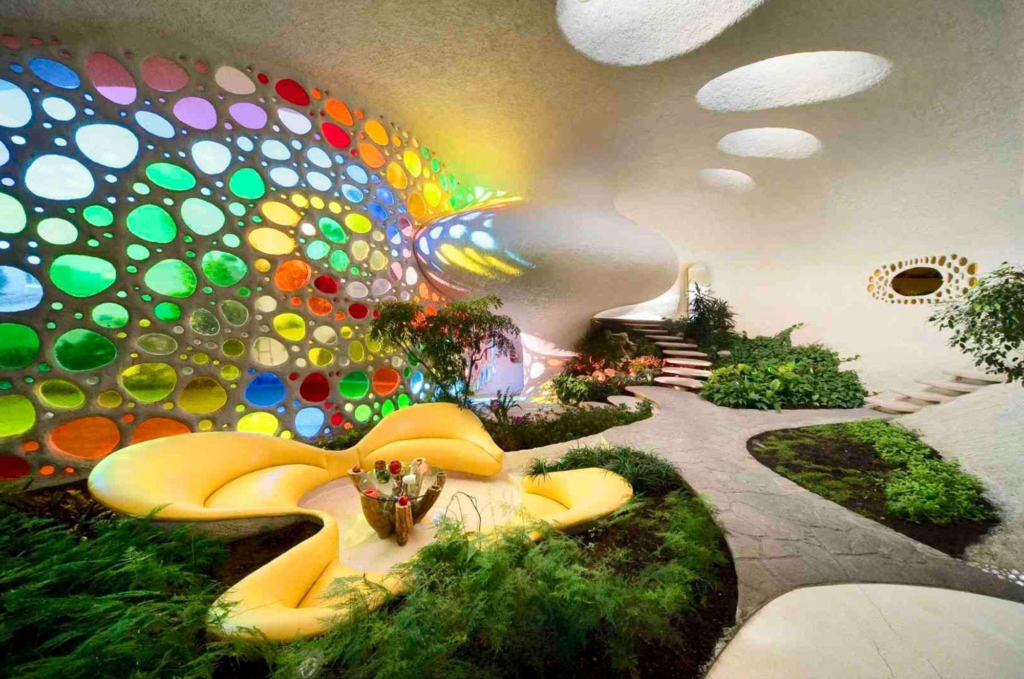
Table of Contents
Defining organic architecture and its principles.
Organic architecture is a design philosophy where buildings are seamlessly integrated with their natural surroundings, creating a harmonious relationship between human-made structures and the environment. This approach emphasizes the use of sustainable materials, energy-efficient methods, and a deep understanding of the surroundings to create functional spaces that coexist with nature. Rather than imposing on the landscape, organic architecture embraces it by taking inspiration from natural forms and incorporating them into the design.
One of the fundamental principles of organic architecture is respecting and enhancing natural ecosystems. The aim is to minimize disturbance to the land while also maximizing its potential for growth and regeneration. This can be achieved through careful placement of buildings, utilizing existing vegetation as shade or windbreaks, and implementing sustainable practices like rainwater harvesting or using renewable energy sources. By doing so, organic architecture not only reduces its impact on nature but also fosters biodiversity within built environments.
Another key principle of organic architecture is creating spaces that reflect human needs while promoting well-being and health. Organic architects prioritize functionality and ergonomics by designing spaces that enhance comfort and connection to nature. Utilizing ample natural light, ventilation systems that promote fresh air circulation, and incorporating elements like gardens or green roofs into designs are just a few examples of how this can be achieved. By placing emphasis on these aspects, organic architecture aims to provide inhabitants with a sense of harmony between their living environment and themselves.
In conclusion, organic architecture goes beyond conventional building practices by integrating structures seamlessly into their natural surroundings while considering sustainability and human well-being at
Origins: Frank Lloyd Wright and the Prairie School.
Frank Lloyd Wright, arguably one of the most influential architects of the 20th century, was the driving force behind the development of the Prairie School architectural style. Born in 1867 in Richland Center, Wisconsin, Wright grew up surrounded by nature and developed a deep appreciation for his surroundings. This love for nature heavily influenced his architectural philosophy and played a pivotal role in shaping organic architecture as we know it today.
The Prairie School emerged in the late 19th century as a response to the rise of industrialization and urbanization. Wright sought to break away from traditional European architectural styles and create a uniquely American aesthetic that reflected the vast Midwestern landscape. Inspired by horizontal lines, open floor plans, and an integration with nature, he transformed what was once considered mere structures into harmonious extensions of their environment.
Wright’s understanding of organic architecture went beyond simply blending buildings with their surroundings; he believed that architecture should be rooted in its cultural context. As such, his designs often incorporated local materials and embraced indigenous craftsmanship. In doing so, he not only created visually striking structures but also fostered a sense of community identity through architecture.
The Prairie School represented a departure from ornamentation-driven designs prevalent during that time period. Instead, simplicity became paramount – geometric shapes combined with clean lines showcased Wright’s commitment to functional design principles. Moreover, by utilizing innovative construction techniques like cantilevers and long horizontal planes, Wright was able to achieve an unprecedented sense of openness within his buildings.
Overall, Frank Lloyd Wright
Characteristics: Integration with nature, use of natural materials.
One of the key characteristics of organic architecture is its integration with nature. Unlike traditional architecture that often imposes human-made structures onto the environment, organic architecture seeks to seamlessly blend with the natural surroundings. This can be achieved by incorporating elements such as landscaped gardens, rooftop gardens, or even building around existing trees and natural formations. By integrating with nature, organic architecture not only creates visually stunning spaces but also fosters a sense of harmony between humans and their environment.
Another distinguishing characteristic of organic architecture is the use of natural materials. Instead of opting for synthetic or artificial materials that are often harsh on the environment, organic architects prioritize utilizing sustainable resources such as wood, stone, and earth. These materials not only have a low environmental impact but also possess a timeless aesthetic quality that further enhances the integration with nature. Additionally, natural materials promote healthy living environments by allowing for better air circulation and reducing harmful toxins commonly found in synthetic building materials.
By emphasizing integration with nature and using natural materials in their designs, practitioners of organic architecture create spaces that connect people to their surroundings on a deeper level. This approach recognizes that we are part of a larger ecosystem and encourages us to live in harmony with our environment rather than conquering it. As we move towards a more sustainable future, embracing organic architecture can help us rediscover our innate connection to nature while creating beautiful and functional spaces that leave a positive impact on both individuals and the planet as a whole.
Key examples: Fallingwater and Guggenheim Museum.
One key example of Organic Architecture is Frank Lloyd Wright’s iconic Fallingwater house. Situated in the Pennsylvania wilderness, this masterpiece seamlessly integrates with its natural surroundings, blurring the boundaries between indoors and outdoors. The horizontal lines and cantilevered construction mimic the rugged landscape, giving the impression that the structure emerges organically from its environment. Inside, large windows frame breathtaking views of waterfalls and forest, connecting inhabitants with nature on a profound level. Fallingwater demonstrates how Organic Architecture aims to create harmony between humans and their surroundings.
Another manifestation of Organic Architecture is found in New York City’s Guggenheim Museum designed by Frank Lloyd Wright himself. Defying conventional museum design, this building features a spiral ramp that leads visitors through an ascending journey of art appreciation. The museum’s distinctive shape mirrors that of a seashell or nautilus shell, symbolizing growth and regeneration – core principles dear to Organic Architecture. With each step taken along the spiraling promenade, visitors are engaged in an intimate interaction with both their physical environment and the displayed artwork—a testament to Wright’s belief in architecture as an immersive experience.
In both Fallingwater and the Guggenheim Museum, these architectural wonders push boundaries beyond functionality to embrace emotion and connection with nature or art respectively—an essential aspect of Organic Architecture’s philosophy. By defying conventional design norms through innovative use of space and materials, these iconic structures show us what it truly means for architecture to become one with its surrounding environment—not just as a static object but as a
Influence on contemporary architecture.
Influence on contemporary architecture has greatly evolved over the years, with organic architecture playing a significant role in shaping modern design. This style of architecture draws inspiration from nature, seeking to create harmonious and sustainable structures that blend seamlessly with their surroundings. One prominent influence on contemporary architecture is the concept of biomimicry, which involves imitating natural forms and processes in architectural design. By observing and learning from nature’s efficient systems, architects have been able to create buildings that not only coexist with their environment but also provide optimal functionality.
Another influential aspect of contemporary architecture is the integration of eco-friendly practices. Sustainable materials and energy-efficient technologies are now key considerations in architectural designs. This shift towards environmentally conscious constructions has led to the rise of innovative building techniques such as green roofs and vertical gardens, which incorporate vegetation into urban spaces for improved air quality and aesthetics.
Furthermore, globalization has had a profound impact on contemporary architecture by fostering cultural exchange and expanding architectural possibilities. Architects now draw inspiration from different cultures around the world, resulting in diverse designs that reflect a globalized society. This intercultural influence can be seen through the fusion of elements from various architectural styles into unique creations.
In conclusion, influence on contemporary architecture encompasses various factors such as biomimicry, sustainability practices, and globalization. With organic architecture serving as a catalyst for innovation, architects continue to push boundaries by creating structures that are both visually pleasing and environmentally friendly. The evolving nature of these influences ensures that contemporary architecture will always be at the forefront of
Criticisms and challenges faced by organic architecture.
Critics of organic architecture argue that it is often more expensive to build than traditional architectural styles. The reliance on natural materials and the need for skilled craftsmanship can drive up construction costs, making it less accessible to the average homeowner or developer. Additionally, the emphasis on sustainability and environmentally-friendly practices can also pose challenges in terms of maintaining and repairing organic buildings over time.
Another criticism faced by organic architecture is its sometimes impractical design approach. While these structures may be aesthetically pleasing, they are not always conducive to modern living standards. The emphasis on natural shapes and forms may result in irregular room layouts or limited space utilization, which can make daily activities more difficult. Moreover, organic architecture’s focus on harmonizing with the surrounding environment often means sacrificing certain functional elements such as ample storage space or efficient heating and cooling systems.
In summary, while organic architecture offers unique designs that blend seamlessly with nature, it also faces valid criticisms and real-world challenges. Higher costs associated with construction and maintenance as well as potential practical limitations raise questions about its feasibility for mass adoption. However, these criticisms should not deter us from appreciating the artistry and vision behind organic architecture or exploring ways to overcome these challenges in pursuit of sustainable and harmonious living spaces.
Conclusion: Organic architecture as a sustainable design approach.
Organic architecture, as a sustainable design approach, offers a holistic solution to the environmental challenges of today. By prioritizing harmony with nature and embracing natural materials, this design philosophy promotes not only the well-being of inhabitants but also that of the planet. By integrating organic principles into architectural designs, we can create structures that are energy-efficient, minimize waste production, and reduce our carbon footprint.
One key aspect of organic architecture is its emphasis on utilizing renewable resources. Rather than relying on unsustainable materials such as plastics or concrete, organic architects opt for biodegradable and locally sourced materials like wood or adobe. This not only reduces the embodied energy in a building but also supports local communities and helps foster a connection with nature.
Moreover, organic architecture goes far beyond just material choices – it reflects an ethos that seeks to understand and mimic the systems found in nature itself. Buildings designed using organic principles often incorporate passive heating and cooling techniques by harnessing natural ventilation or strategically positioning windows for optimal daylighting. In doing so, they mitigate reliance on mechanized heating or air conditioning systems and greatly reduce energy consumption.
In conclusion, by embracing organic architecture as a sustainable design approach, we have an opportunity to not only create visually stunning buildings but also contribute to the health and well-being of both individuals and the environment they inhabit. Organic architecture offers us a way forward towards a more regenerative future where our built environment coexists harmoniously with nature rather than causing harm. It is through this holistic framework that we can achieve true sustainability


